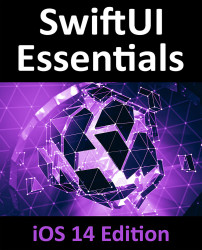Overview of this book
Do you want to create iOS apps with SwiftUI, Xcode 12, and Swift 5.3, and want to publish it on the app store? This book helps you achieve these skills with a step-by-step approach.
This course first walks you through the steps necessary to set up an iOS development environment together and introduces Swift Playgrounds to learn and experiment with Swift—specifically, the Swift 5.3 programming language. After establishing key concepts of SwiftUI and project architecture, this course provides a guided tour of Xcode in SwiftUI development mode.
The book also covers the creation of custom SwiftUI views and explains how these views are combined to create user interface layouts, including the use of stacks, frames, and forms. One of the more important skills you’ll learn is how to integrate SwiftUI views into existing UIKit-based projects and explain the integration of UIKit code into SwiftUI.
Finally, the book explains how to package up a completed app and upload it to the app store for publication. Along the way, the topics covered in the book are put into practice through detailed tutorials, the source code for which is also available for download.
By the end of this course, you will be able to build your own apps for iOS 14 using SwiftUI and publish it on the app store.
The code files for the book can be found here:
https://www.ebookfrenzy.com/retail/swiftui-ios14/



